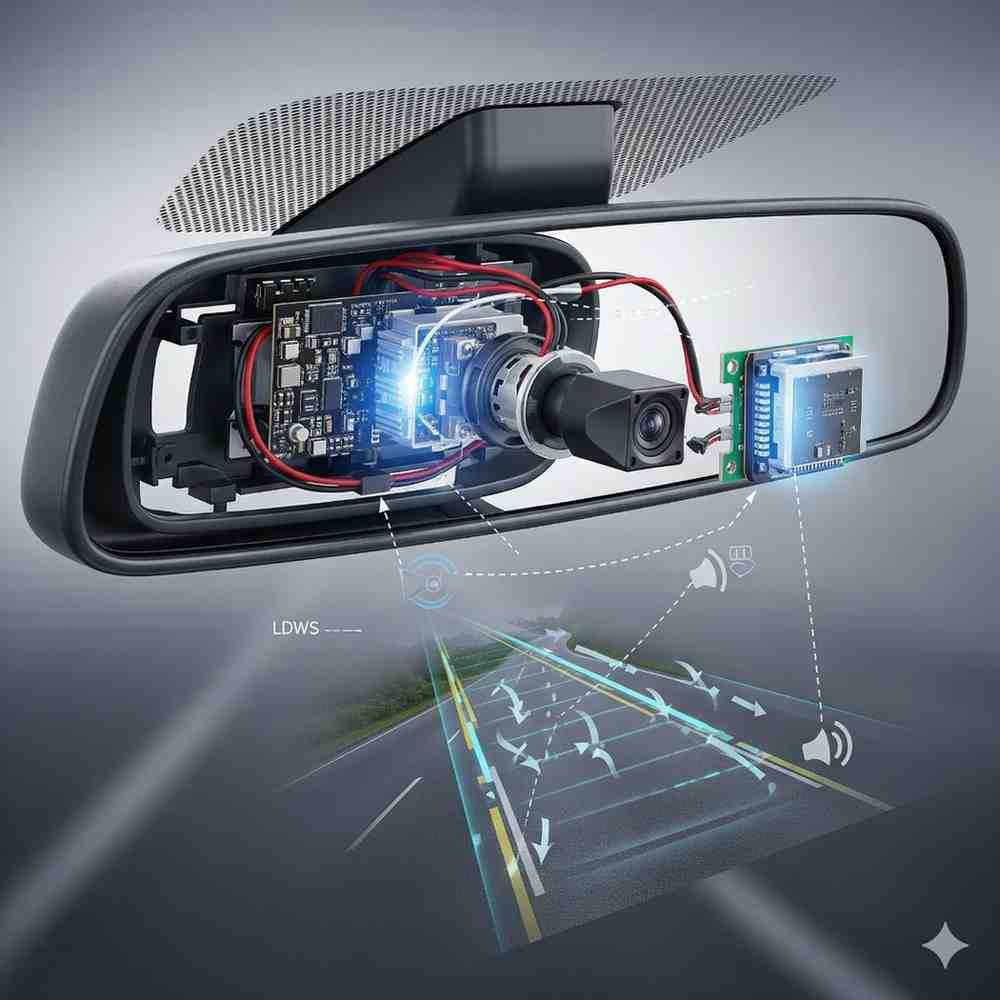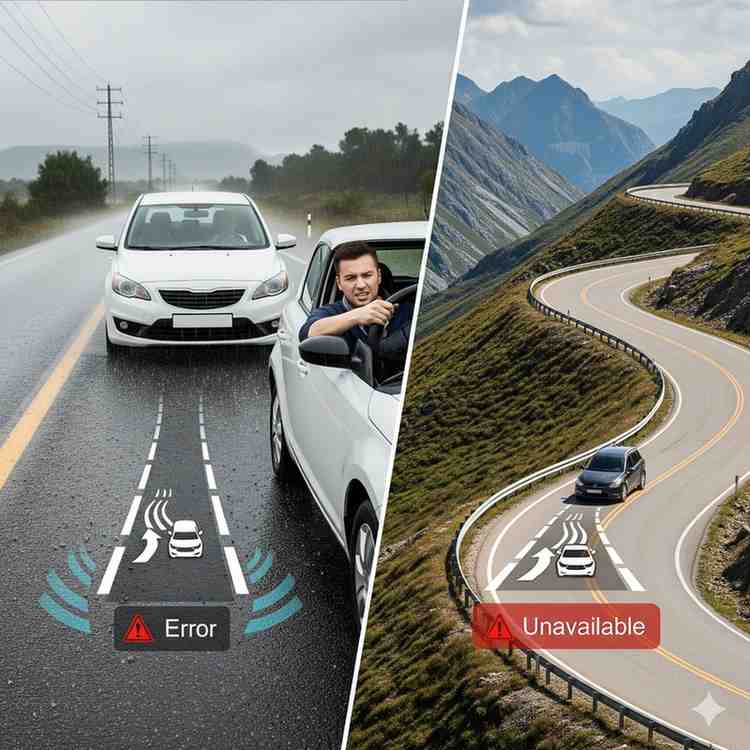In the world of modern driving, advanced safety systems have become integral to reducing accidents and promoting safe driving habits. Among these systems, the Lane Departure Warning System (LDWS) stands out as a crucial technology. Designed to prevent unintended lane drifting, this system ensures that drivers maintain their intended path, reducing accidents caused by distracted or fatigued driving.
In this article, we will explore the Lane Departure Warning System, its benefits, how it works, the technology behind it, and the challenges associated with its use. We’ll also look at its role in the future of autonomous driving and road safety.
What is a Lane Departure Warning System?
The Lane Departure Warning System (LDWS) is an advanced driver assistance feature designed to enhance road safety. It helps prevent vehicles from unintentionally drifting out of their lane. Using cameras and sensors, the system detects the vehicle’s position within the lane. If the vehicle starts to move outside its designated lane without the use of turn signals, the system alerts the driver.
This alert can come in the form of an audible warning, vibration in the steering wheel, or visual notifications on the dashboard. The Lane Warning System is particularly helpful in preventing accidents caused by driver inattention, drowsiness, or distractions.
How Does a Lane Departure Warning System Work?
The Lane Departure Warning System relies on forward-facing cameras that are mounted near the rearview mirror. These cameras continuously scan the road ahead, monitoring the position of the vehicle relative to the lane markings. The system analyzes real-time data and determines whether the vehicle is staying within its lane.
If the vehicle starts to drift or move outside the lane boundaries without signaling, the system activates a warning. This warning is intended to alert the driver to correct their steering and return to their lane safely. However, it’s important to note that the Departure Warning System does not automatically steer the vehicle; it simply alerts the driver to take corrective action.

Image: Benefits of a Lane Departure Warning System
Benefits of a Lane Departure Warning System
1. Accident Prevention
One of the primary benefits of the Departure Warning System is its ability to prevent accidents. Unintended lane drifting is a leading cause of road accidents, especially when drivers are fatigued, distracted, or inattentive. The LDWS helps reduce the risk of side-impact and head-on collisions by providing early warnings when lane drifting occurs. These warnings give drivers the opportunity to correct their course before an accident happens, ultimately enhancing overall road safety.
2. Driver Awareness and Focus
The Lane Departure Warning System is designed to improve driver awareness and maintain focus on the road. Long drives, particularly on highways, can lead to driver fatigue and reduced concentration. The LDWS acts as an additional layer of safety, keeping the driver alert. By providing timely reminders when the vehicle veers off course, the system encourages drivers to stay focused on maintaining lane discipline, especially during long or monotonous drives.
3. Supporting Novice and Elderly Drivers
New and elderly drivers often face challenges when it comes to maintaining lane discipline, especially in high-traffic or unfamiliar areas. The Lane Departure Warning System offers added support for these drivers, providing them with extra confidence on the road. By alerting them to potential lane drifting, the system can help inexperienced or older drivers stay in their lane and avoid dangerous driving errors.
4. Enhanced Driving Safety in Poor Visibility
Poor visibility conditions, such as rain, fog, or snow, can make it difficult for drivers to see lane markings clearly. In such conditions, the Lane Departure Warning System serves as a valuable tool to help drivers stay within their lanes. The cameras and sensors in the system are capable of detecting lane boundaries even in low-visibility situations, helping drivers maintain control and avoid drifting unintentionally.
5. Encouraging Better Driving Habits
By alerting drivers to their lane discipline, the Departure Warning System promotes safer driving habits. Drivers are less likely to engage in distracted driving behaviors such as texting, eating, or adjusting the radio when they know the system is actively monitoring their position on the road. This awareness encourages a more responsible and cautious approach to driving, ultimately contributing to road safety.

Image: The Technology Behind Lane Departure Warning Systems. A cutaway diagram of a car’s rear view mirror assembly, revealing the internal components of a Lane Departure Warning System (LDWS). A small, high-resolution camera lens is visible, positioned to capture the road ahead. Wires and circuit boards are intricately arranged around the camera, connecting to a miniature control unit. The control unit has a faint blue glow emanating from within, symbolizing its active state. The diagram includes a transparent overlay showing the camera’s field of view on a section of a road with visible lane markings. Animated lines within this overlay illustrate the system’s ability to detect and track these lane markings. Subtle graphic elements like small data packets and dashed lines indicate the flow of information from the camera to the control unit and then to an unseen warning mechanism (like an audio output or vibrating steering wheel). The background is a blurred, neutral gray to keep the focus on the diagram.
The Technology Behind Lane Departure Warning Systems
The Departure Warning System is a sophisticated technology that relies on cameras, sensors, and algorithms to function effectively. These components work together to detect lane markings and monitor the vehicle’s position in real-time.
1. Camera and Sensor Technology
The system’s primary component is a forward-facing camera, typically mounted near the rearview mirror. This camera captures continuous images of the road ahead, focusing specifically on the lane markings. In some systems, additional sensors may be used to assist with lane detection, especially in conditions where lane markings are faded or poorly visible.
2. Image Processing Algorithms
Once the camera captures images of the road, the Lane Departure Warning System uses advanced image processing algorithms to analyze the data. These algorithms identify the lane boundaries and calculate the vehicle’s distance from the center of the lane. If the vehicle deviates from its lane without signaling, the system activates the warning.
3. Warning Systems
The Lane Departure Warning System uses various methods to alert the driver. These include audible beeps, vibrations in the steering wheel, or visual alerts on the dashboard. Some systems may offer customizable alert options, allowing drivers to choose their preferred form of notification.
Challenges of Lane Departure Warning Systems
While the Departure Warning System offers many benefits, it also presents certain challenges and limitations that need to be addressed for optimal performance.
1. Weather and Environmental Conditions
One of the biggest challenges for Lane Departure Warning Systems is their reliance on clear lane markings. In poor weather conditions such as heavy rain, snow, or fog, the cameras may struggle to detect lane boundaries. Similarly, faded or poorly maintained lane markings can reduce the system’s accuracy, leading to false warnings or failure to detect lane drifting.
2. Overreliance on Technology
While the Lane Departure Warning System enhances safety, there is a risk that drivers may become too reliant on the technology. The system is not a substitute for active driving; drivers must remain attentive and in control of the vehicle at all times. Overconfidence in the system’s capabilities could lead to complacency, making drivers less vigilant on the road.
3. False Alarms
In some cases, the Lane Warning System may issue false alarms. For example, the system might misinterpret road features such as cracks, shadows, or construction lines as lane markings. These false alarms can be frustrating for drivers and may reduce their trust in the system.
4. System Limitations in Complex Roadways
While Lane Departure Warning Systems are highly effective on highways and straight roads, they may struggle in more complex driving environments such as city streets or winding roads. In these situations, the system may not be able to detect lane boundaries accurately, reducing its effectiveness.

Image: Challenges of Lane Departure Warning Systems
The Role of Lane Departure Warning Systems in Autonomous Driving
As the automotive industry moves toward fully autonomous driving, the Lane Departure Warning System plays a key role in the transition. Autonomous vehicles rely heavily on lane-keeping and lane-centering technologies, making LDWS a foundational component of advanced driver assistance systems.
In the future, Departure Warning Systems are expected to evolve into more sophisticated lane-keeping assist features, where the vehicle not only warns the driver but also automatically steers the car back into its lane. This development will be a crucial step toward achieving fully autonomous vehicles that require minimal driver intervention.
FAQs: Lane Departure Warning System
Q: What is the primary purpose of a Lane Departure Warning System?
The primary purpose of the Lane Warning System is to prevent unintended lane drifting by alerting drivers to lane deviations.
Q: Does the Lane Departure Warning System steer the vehicle back into its lane?
No, the Warning System only provides warnings. It does not actively steer the vehicle back into its lane.
Q: How does the system detect lane drifting?
The system uses forward-facing cameras to monitor lane markings. It issues warnings if the vehicle drifts outside the lane without signaling.
Q: Can the Lane Departure Warning System function in poor weather conditions?
While the system is highly effective, its performance may be reduced in poor weather conditions like heavy rain, fog, or snow.
Q: What kind of warnings does the system provide?
The Lane Departure Warning System provides audible warnings, steering wheel vibrations, or visual alerts on the dashboard to notify drivers.
Q: Can the system issue false alarms?
Yes, in some cases, the system may issue false alarms due to road features like cracks, shadows, or construction lines being misinterpreted.
Q: Is the Lane Departure Warning System available in all vehicles?
Currently, the system is available in many mid-range and high-end vehicles. It is becoming more widespread as part of advanced safety features.
Q: Does the Departure Warning System work at night?
Yes, the system works at night, but it may face challenges in low-visibility situations. Advanced sensors help improve its accuracy at night.
Conclusion
The Lane Departure Warning System is an essential technology that enhances road safety by reducing the risk of unintended lane drifting. By alerting drivers to potential dangers, this system encourages better driving habits and keeps roads safer for everyone. While the technology comes with certain challenges, such as weather limitations and false alarms, its benefits far outweigh the drawbacks.
As the system continues to evolve, it will play an increasingly important role in the development of autonomous driving technologies. With ongoing advancements in sensor accuracy and image processing, the Lane Departure Warning System is set to become a standard feature in the future of









Leave a Review